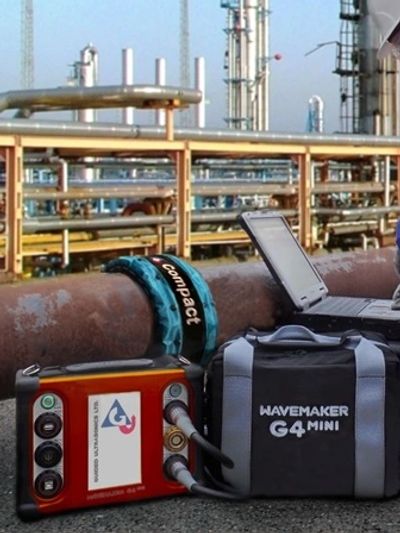LONG RANGE ULTRASONIC TESTING (LRUT)
Introduction
LRUT (Long-Range Ultrasonic Testing) is a non-destructive testing technique that utilizes low-frequency ultrasonic waves to inspect large volumes of material for defects.
LRUT works based on the principle of guided ultrasonic waves. Low-frequency ultrasonic waves are introduced into the material through a transmitter, which generates guided waves that propagate along the length of the material. These waves interact with any defects or changes in the material's cross-section, causing reflections that are detected by receivers. By analyzing the received signals, defects such as corrosion, wall loss, and other anomalies can be detected and located.
Application:
LRUT is commonly used for inspecting long sections of pipes, tubes, and other structures, particularly in industries such as oil and gas, petrochemicals, power generation, and transportation. It is especially suitable for detecting and mapping corrosion, erosion, and other defects in pipelines, both above and below ground. LRUT is advantageous for inspecting inaccessible or hard-to-reach areas without the need for extensive excavation or disassembly.
Standard Code Reference:
Various standards and guidelines provide guidance for LRUT, depending on the specific application and industry. For pipeline inspections, relevant codes include
- ASME B31.8 (American Society of Mechanical Engineers) - "Gas Transmission and Distribution Piping Systems,"
- API 570 (American Petroleum Institute) - "Piping Inspection Code: In-Service Inspection, Rating, Repair, and Alteration of Piping Systems," and
- ISO 16809 - "Non-destructive testing -- Ultrasonic testing -- Guided wave testing."
Advantages:
- Long Inspection Range: LRUT can inspect long sections of materials, covering several meters in a single scan, thereby reducing inspection time and costs.
- Rapid Inspection: LRUT can quickly scan large areas, making it suitable for inspecting extensive pipeline networks.
- Inaccessible Area Inspection: LRUT can inspect areas that are difficult to access, such as buried or insulated pipelines, without the need for excavation or disassembly.
- Comprehensive Coverage: LRUT provides volumetric coverage, detecting defects over the entire circumference of the material, including hidden defects and those located between inspection points.
- Minimal Surface Preparation: LRUT requires minimal surface preparation, allowing inspections to be performed on coated or painted surfaces without extensive cleaning or removal.
Limitations:
- Limited Defect Sizing: LRUT is primarily used for detecting and locating defects but may have limitations in accurately sizing or characterizing the exact dimensions of defects.
- Limited Resolution: The resolution of LRUT may be lower compared to traditional ultrasonic testing methods, making it less suitable for detecting smaller defects.
- Dependency on Material and Geometry: The effectiveness of LRUT can vary depending on the material properties, thickness, and geometry of the structure being inspected.
- Operator Training: Skilled operators are required to set up the LRUT equipment, interpret the results, and distinguish between real defects and false indications.
- Complex Data Interpretation: LRUT data analysis can be complex, requiring expertise to interpret and distinguish between normal reflections and indications of defects.
When conducting LRUT inspections, it is important to follow relevant standards, guidelines, and best practices. Proper training and qualification of operators, as well as regular calibration and maintenance of the equipment, are necessary to ensure accurate and reliable results. Combining LRUT with other inspection techniques, such as visual inspection or ultrasonic thickness measurement, can provide a more comprehensive assessment of material integrity.
Copyright © 2024 Brotherhood Technical Services Company - All Rights Reserved.
Powered by BTECH
This website uses cookies.
We use cookies to analyze website traffic and optimize your website experience. By accepting our use of cookies, your data will be aggregated with all other user data.
